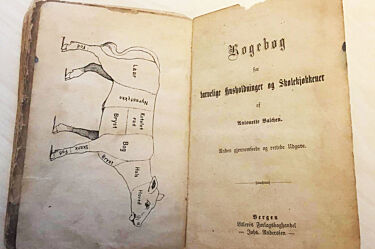
Object of the month: Cookery book from 1897
There is a lot of good food and cultural tradition in the history of cookery books. Prior to the 1700s it was usually men who wrote them, but in the 1800s it is the women who take over, something which can be seen in the contents of the books. Men tended to concentrate mainly on the themes that were men's responsibility, and as a result there was more focus on the farming and agriculture than on exactly how to prepare the food. When women began to write cookery books they started to write exact food recipes and since that is what they really wanted to know. This was also the motivation for the priest's wife, Hanne Winsnes (1789-1872), who at that time was the equivalent of the TV cooks of today. At the age of 17 she was responsible for the upkeep of her little sister's house, and later on she was eager to "spare others from the duties of running a household without a textbook to guide them." Her Textbook on the various branches of housekeeping (1845) was the most widely read Norwegian cookery book and was published in 13 editions up to 1921.
The object of this month is the Cookery book for frugal housekeeping and school kitchens by Antonette Balchen (1848-1917), and is written in the spirit of Hanne Winsnes. Balchen was a domestic science teacher and headmistress of a home crafts and housekeeping school in Bergen. Nowadays the word "frugal" has a negative ring about it, but at the time it meant "simple," and there were a number of cookery books aimed at "frugal" housekeeping. Balchen writes in the foreword to the book:
"What I have especially missed in the many cookery books I have become familiar with during the course of my career is a list of food recipes of a frugal nature. Many are of the opinion that frugal meals are: Bread, soup, herrings and fish prepared in the simplest ways. But this is not true, as you can see in my book. There is a preconceived notion that if food is well presented and tasty it must of necessity be expensive."
If you would like to try out a really "frugal" recipe you can look for inspiration in the recipes taken from the book. How about, for example a heartwarming beer soup this evening? Or a jelly made from first milk?
Anne Klippenvåg Pettersen - curator